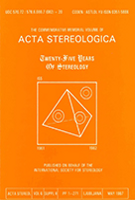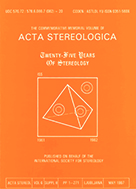- Home
- Volume 17 (1998)
- Number 1 - June 1998
- Lymphoid infiltrates in the bone marrow: 3D aspects
View(s): 477 (3 ULiège)
Download(s): 182 (1 ULiège)
Lymphoid infiltrates in the bone marrow: 3D aspects

Abstract
The distinction between benign and malignant lymphocytic infiltrates present in bone marrow trephine biopsies is important for primary diagnosis of malignancy, lymphoma staging and prognosis. No single criterion exists to make this distinction and so discrimination is made on the basis of a number of morphological observations, often supplemented by immunohistochemical staining of tissue sections. In recent years, attention has been given to the pattern of infiltration shown by benign and malignant lymphoid infiltrates in the bone marrow. Three-dimensional reconstruction studies and, to a lesser extent, stereological investigations have shed new light on the microarchitecture of the marrow and provided three- dimensional models of pathological states. The three-dimensional reconstruction studies have shown that benign lymphoid aggregates occupy the central marrow spaces, away from the bone trabecular surfaces (non-paratrabecular). In contrast, bone marrow infiltrates of follicular lymphoma, a low-grade non-Hodgkin's malignant lymphoma, always occupy, at least in part, the zone next to the bone marrow trabeculae. This is described as a paratrabecular pattern of infiltration. Other types of low-grade non-Hodgkin's lymphoma may show either or both patterns i.e. non-paratrabecular and/or paratrabecular. That different types of lymphoid infiltrates show different patterns of marrow infiltration could be explained either by an intrinsic difference in the lymphoid cells or by the way in which they are responding to regulators of the haematopoietic microenvironment. Possible regulators of marrow microenvironments include the haematopoietic precursors themselves, the marrow stromal cells, the extracellular marrow matrix, haematopoietic cytokines and growth factors. Because the pattern of paratrabecular infiltration shown by follicular lymphomas is similar to the paratrabecular zoning demonstrated by normal granulopoiesis, similar regulator(s) of the haematopoietic microenvironment may be important in determining this spatial architecture.






